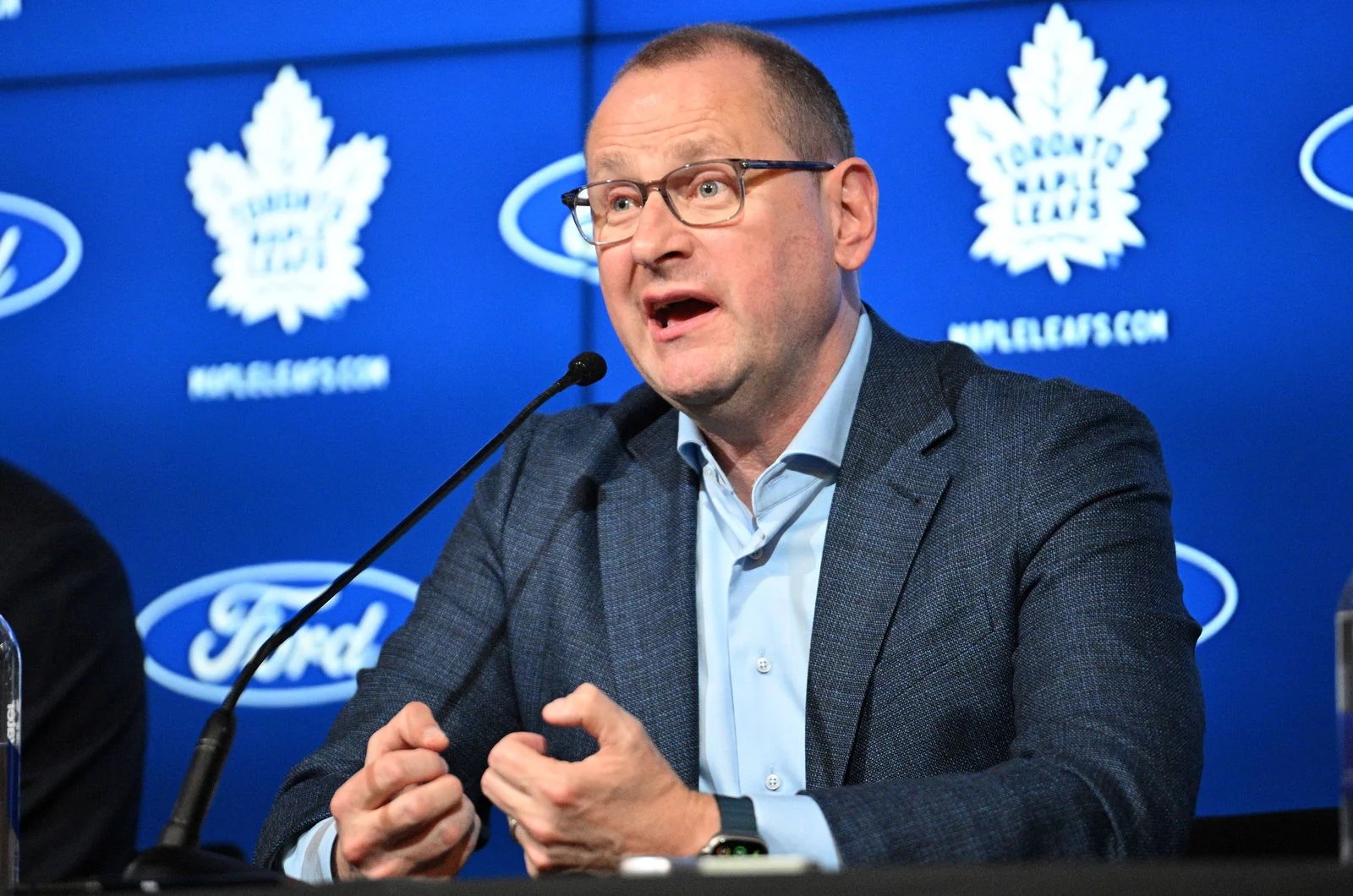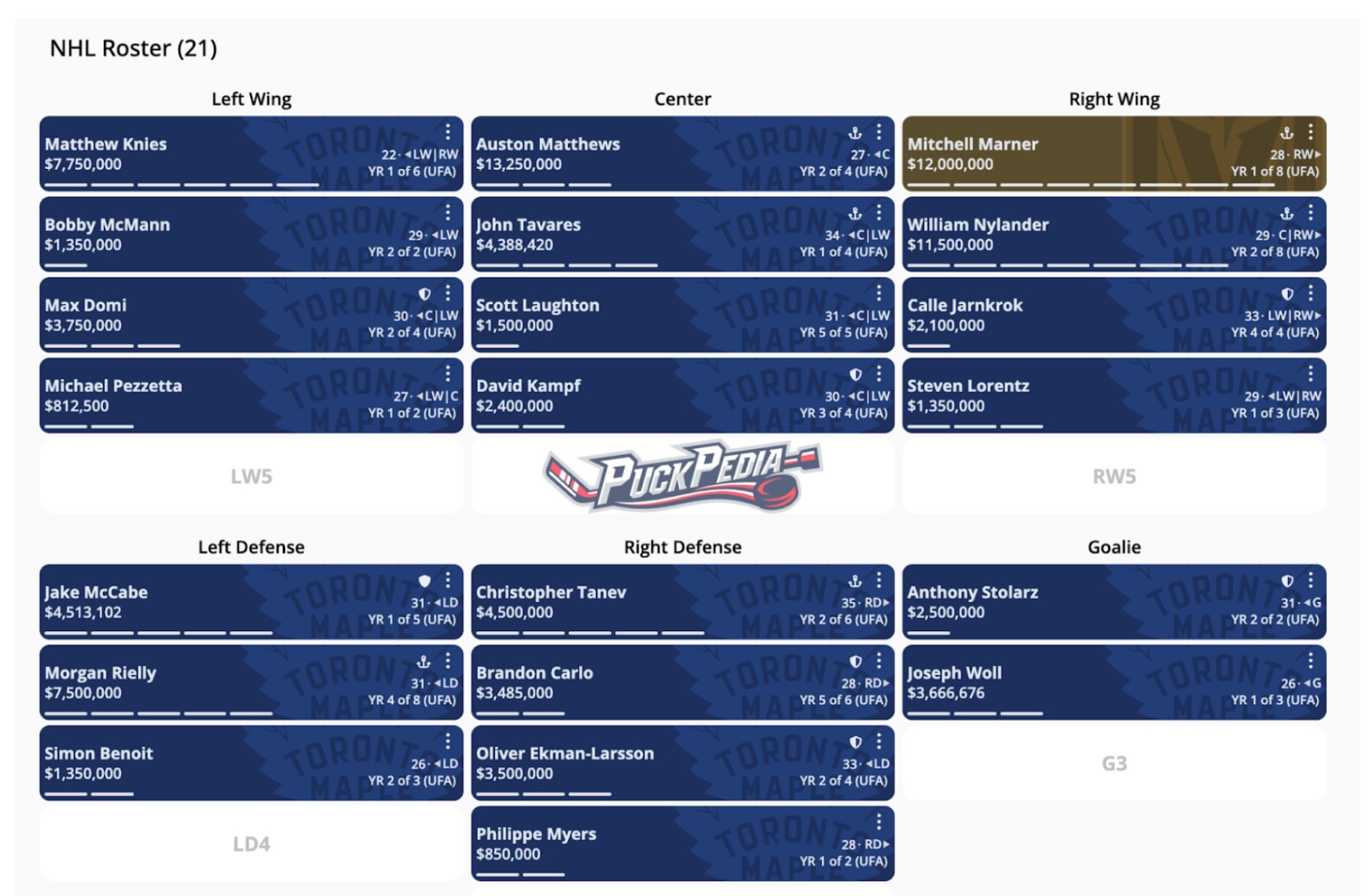Just a few weeks into the NHL offseason, we can conclude that free agency was practically over before it started. The rising salary cap has led to over half the league still possessing notable cap space, which has, in turn, slowed the trade market down to a crawl.
Even though there is ample time for things to change — and they likely will, given the collection of RFAs still in need of new deals, some reasonable UFAs on the open market, trades trickling through, etc. — it’s tough not to start already looking at the Leafs roster as it is. This also marks a good time to review the Leafs‘ offseason so far.
It’s hard to analyze the Leafs‘ offseason to date and argue the team has actually improved over last season… yet.
Short of bringing in another star to replace Mitch Marner straight up, the fact is that he played massive minutes and in every situation for the team. It’s difficult to predict how everything will shake out when a team removes such a major minute-eater. And there’s still a lot of uncertainty about who will be on the team by October, let alone how the new and old pieces will fit together.
It will be a brand new world in Leafland, and while I won’t sit here and definitively proclaim the new era will be better than the old (I think they need to add a quality forward before I can really get there), I’ve found myself pondering this hypothetical: What if the Leafs kept Marner?
As Chris Tanev said at one point, Marner was their best player last season. It would be foolish to argue otherwise, and when the season ended, under the right circumstances (salary), I wanted him to return. But as the playoffs went along, it became more and more difficult to justify it.
Marner wasn’t the only one who didn’t elevate his game, but as one of the top players on the team, he rightfully receives a lot of attention, which he wanted no part of. The team completely no-showed the two biggest games of the Core Four era in Game 5 and Game 7 against Florida. We can’t ignore it, and when we found out in the aftermath of Marner’s decision to leave that he was chatting about life in Vegas while at the Four Nations, only to play as he did in those aforementioned playoff games… I mean, there’s not much else to say.
Even with all of that context in mind, there is still so much talk about the Leafs losing a 100-point player, but truthfully, with the way the offseason has shaken out, keeping Marner might have been just as — if not more — problematic. That’s before we consider how he clearly and openly — to teammates and the league — he wanted to leave and was unhappy in Toronto. The hypothetical of keeping Marner is worthy of some discussion before we frame the Leafs’ subsequent offseason moves, with some potential for (gasp!) optimism, especially compared to some of the reactions in the market over losing the homegrown star.
A hypothetical world with Marner still in Toronto
Even if we generously assume that Marner would have taken the same $12 million AAV to stay (there was zero chance of this, for the record), the Leafs would have been staring down the prospect of running back about the same roster as last season, if not worse.
The roster below leaves the team with under $800K in cap space. Honestly, is it good?
Quibble with the lines all you want, but it’s irrelevant.
The Leafs wouldn’t have been able to afford re-signing Nick Robertson, let alone much else. It’s essentially a money-in-for-money-out situation. Depending on any trades, the above lineup could simply be their opening-day roster. This is not a particularly appealing scenario to me.
I can already hear people suggesting they could trade Calle Jarnkrok and/or David Kampf to clear cap space; they are clearly trying to do this anyway and have been unsuccessful so far. Sure, this may change as the summer progresses, but I’m not entirely convinced they can cleanly (i.e., no retention, and no money coming back) get rid of *both* players at this point.
Either way, let’s play ball and pretend they trade away both Kampf and Jarnkrok — with zero penalty/poor contract returning the other way — to create some cap space and make changes other than simply re-signing Marner and Steven Lorentz.
There would be two open forward spots above and roughly $5.2 million ($5,258,081) to fill those spots. That’s basically two $2.6 million players or one $4-ish million player and a $1-ish million player, or anything in between those combos. They would run a capped-out team with a minimum 12-forward lineup in an Olympic season with a condensed schedule, a roster that features an $812K Michael Pezzetta as an everyday regular.
What is the hope based on what just happened in free agency? Pius Suter and a depth player around $1 million, like Cole Koepke? Hoping to win an arbitration case against Nick Robertson to keep him around $1 million?
We could split the difference and find a few players worth plus or minus $2.6 million, like Brandon Tanev, Anthony Beauvillier, Joel Armia, Justin Danforth, or maybe an Anthony Mangiapane, along with an under $1 million player like Nick Cousins.
The Leafs would be subbing out Pontus Holmberg, Max Pacioretty, and Calle Jarnkrok from last year’s playoff group in exchange for a combo of Michael Pezzetta + middling player + middling player, or Pezzetta + reasonable player + super cheap depth player. I don’t see how this is better than the current situation or a scenario worth locking the team into at this point.
Again, this is all based on the best-case scenario of:
- Marner signing for $12 million (no chance he’d sign that in Toronto)
- Trading Calle Jarnkrok and David Kampf cleanly off the roster with no salary retention/salary coming back in return (we’ll see)
- Running a 12-forward minimum lineup featuring Pezzetta nightly (they should never, ever do this in any season, let alone an Olympic year)
The Leafs would be bending over backward in order to run back the same core, with the same plan (two top lines, two bottom lines) — a formula that hasn’t worked in the playoffs — and again betting on the same group that hadn’t elevated in the most critical moments.
There is also the matter of how the previous group was aging together. I hate to keep repeating the same points, but they were 29th in five-on-five possession last season, they posted the third-highest five-on-five PDO in the league, won the most one-goal games, and relied heavily on goaltending and their defense blocking shots/boxing out. It got them really good results last season in terms of winning the division in the regular season — there’s no rewriting history on that accomplishment — but as we turn the page to a new season, it’s an unsustainable recipe for success. They can’t be outplayed on a night-to-night basis, year over year, and expect to sustain good results, let alone break through in the playoffs. It’s not a process worth quadrupling down on.
It felt more like the stars were potentially aligning for a chance to ride some luck into the final four, rather than an elite team imposing its will on the opposition night in and night out. The 2024-25 Leafs adopted a rope-a-dope type of game where they were routinely outshot and out-possessed, relying heavily on their goaltending and their star players to counterattack and cash in when opportunities struck.
Marner may win in Vegas, but it’s clear at this point that it was not going to happen in Toronto. He played nine seasons here; he couldn’t handle the media or the fan attention, and he regularly wilted in the spring. He refused to change his game, and whenever he was asked about it, he’d come off as more defensive than accountable. He scored twice in the playoffs this spring; one was a breakaway created entirely by Matthews in G1R1, and the other was blindly throwing a rolling puck to the net. He’s repeatedly refused to go to the toughest areas of the ice to score in the postseason. Again, maybe this changes in Vegas, or maybe the Golden Knights do a better job of compensating for it with different players around him. But it wasn’t happening in Toronto, and Marner’s contract would have yet again hampered the team from meaningfully improving/upgrading the rest of the roster.
Yes, to some degree, Marner is the scapegoat, but the reality is that he didn’t want to be in Toronto any longer, and he couldn’t handle the market. That is absolutely a player who needed to go.
For all the talk about losing Marner and the difficulty of replacing him, I’d be more concerned about signing him to an extension at this rate. Of course, the one point of true frustration through it all is that they didn’t maximize a proper trade return years earlier.
The Leafs’ roster picture as it is
The good news is that the Leafs did manage to net a return for Marner, and while it’s not a star player coming back, Nicolas Roy is a really important piece.
When Vegas won the Cup three seasons ago, Roy averaged 15 minutes per game in the playoffs — that’s notable, top-nine forward ice time on a Cup champion, not depth/non-factor ice time. For reference, this spring, only five Leafs forwards averaged more than *13:52* per game (the player at 13:52 was Scott Laughton).
On Real Kyper and Bourne, Brad Treliving laid out a bit of a blueprint:
“I have used the analogy of Winnipeg. No team is perfect, but that is a pretty darn good team that won the President’s Trophy. When you look down the middle of the ice, you have Scheifele as the #1. On paper, you have Namestnikov as #2 and Lowry as #3, but again, it all comes down to deployment.
When you look at our roster now, you have Nic Roy, who can take a lot of defensive heavy lifting with defensive-zone starts, defensive faceoffs, and matchups. When you put those into a pot, it allows you to not necessarily get lost on your 1-2-3 but spread out matchups and situational play that could free up different people when we talk about Auston, John, and Scotty Laughton.
When I look down the middle of our ice right now, it gives us a lot of different options.”
While the Leafs haven’t been able to add a new 2C to push Tavares down the lineup, they’ve still meaningfully improved their overall group. If Roy can anchor a proper checking line, it means Tavares isn’t taking top-six matchups every night, and Matthews won’t face among the most difficult workloads in the league. Matthews will still need to go head-to-head (naturally), but likely not to the same degree, and those are little victories that add up over 82 games and hopefully lead to not just more offense but more control over the play.
Last year, the Leafs’ season-opening center group was Matthews-Tavares-Holmberg-Kampf. The top two still remain, but they changed the bottom two for the (much) better.
The team still needs at least one, if not two, quality wingers depending on how things shake out (i.e., how does Matias Maccelli do, can Max Domi rebound on the wing, etc.). But these are much easier assets to find during the season than a center or defenseman. Wingers can always be acquired; it’s the least important position in the sport.
The biggest question mark is the health of Auston Matthews. If he is 100%, there’s reason to be bullish about this group. If he’s not, well… the hypothetical of Marner or not is irrelevant other than Marner increasing their floor in the regular season. And how much does that really matter to the organization at this point?
Assuming full health, a reconfigured forward group can net a better process that hopefully leads to better playoff success down the road. It’s still an incomplete group — and it feels like there is more to come — but we’re in uncharted territory where the Leafs actually have cap space. With the cap space comes the opportunity to add proper difference makers.
At this point, this is a better position than committing all their cap space upfront to a player who has been in Toronto for nearly a decade, soured on the market, and was a large part of a group that didn’t even come close to breaking through when it mattered.
Short of winning it all at some point in the next few years, there will always be some dread and regret around not fetching more for Marner years earlier. We can’t fully brush it off. But from when the season ended to now, I’m okay with the decisions and have a refreshed level of intrigue and excitement about the team as a whole.
A quality 3C, a decent bet on a young player with upside, no more Marner drama, and ample cap space to continue to add.
We’ll see if Leafs management can make good use of the cap space eventually, but it’s not just a good pivot; it’s significantly better than overpaying a player, yet again, to convince him to stay.















![John Gruden after the Leafs prospects’ 4-1 win over Montreal: “[Vyacheslav Peksa] looked really comfortable in the net… We wouldn’t have won without him” John Gruden, head coach of the Toronto Marlies](https://mapleleafshotstove.com/wp-content/uploads/2025/09/gruden-post-game-sep-14-218x150.jpg)



















